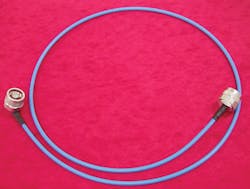A line of low-passive-intermodulation (PIM) jumper cables from Microlab, a Wireless Telecom Group company, has been extended for applications from DC to 3 GHz. The firm’s JP/JR/JS series jumper cables are suitable for telecommunications applications in frequency bands from 380 to 2700 MHz. The cable assemblies are based on 0.141-in.-diameter cables with silver-plated copper conductors and PTFE dielectric material. The cables feature better than 90-dB shielding; they can handle 100 W average power and as much as 3 kW peak power. The jumper cables are available with straight and right-angle Type N and 7/1-DIN connectors. The cables feature trimetal plated connectors made to MIL-C-39012 specifications. The PIM performance is better than -150 dBc when tested with two +43-dBm tones and guaranteed to -145 dBc at 1800 MHz. Cable lengths of 0.5 and 1.0 m are available from stock. Typical loss for a 0.5-m cable at 2700 MHz is less than 0.6 dB.
Microlab, a Wireless Telecom Group, Inc., 25 Eastmans Rd., Parsippany, NJ 07054; (973) 386-9696, FAX : (973) 386-9191, www.wtcom.com.
